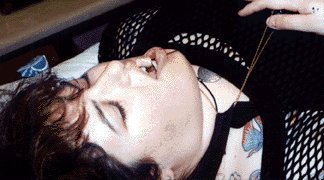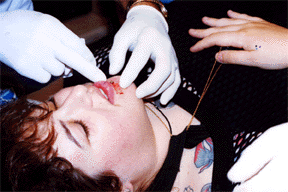Lip Piercing 1994-1997
Alas, as you view these labret (lip) piercing images (left photos), I no longer keep jewelry in this piercing. I had the piercing done at one of Fakir's piercing school sessions. After three years, the fishtail jewelry was eroding my gums just under my lower right front tooth. I decided that rather than planning for years of unknown dental adventures and procedures, I would abandon that piercing. It made me really sad, that was my favorite. There is still a small hole visible just under my lower lip, and I can still feel where it was on the inside of my lip with my tongue.


One of the more unusual piercings, both in ancient and modern practice, is the labret, or lip piercing. The term “labret” is Latin in origin, meaning “lip” but it is the umbrella term for all piercings around the opening of the mouth. Primitive and contemporary piercings are found in both the upper and lower lips in a variety of thicknesses and placements.
In the past, the mention of a lip piercing brought to mind exotic Africa and large wooden disks. Many people probably now imagine any number of dark-clad young people with silver lip and nose rings who work at the corner store or are their own children. In essence, these two ends are achieved through nearly the same means, but in each case the person is operating under different cultural norms and treats the piercing differently during healing.
Placement of lip piercings can vary quite a bit, and often jewelry choice is related to the location and size of the piercing. Lower lip piercings can be centered or placed as desired almost anywhere along the lower lip line. Rings are frequently worn for lower lip piercings, but curved tusks, short spikes and studs can be worn if desired.
Upper lip piercings frequently are “beauty mark” style, sometimes called a Madonna piercing, after the singer’s beauty mark. A tiny barbell or stud is most often worn in upper lip piercings, to make the piercing most resemble the namesake beauty mark placement. More often the style of backing chosen for post-style jewelry becomes more important than the part that shows outside the mouth.
Non-ring labrets can come with disk backs or fishtails. Posts that end with disk backs have a small flat circle of metal that screws to the jewelry, sometimes on the disk side inside the mouth, and sometimes a barbell end that caps the post on the outside. Fishtail-finished jewelry has a wire that lies along the inside of the lip perpendicular to the piercing, staying in place using much of the same principles as the Indian nostril screw does for nose piercings. This jewelry is inserted into the piercing from the front and twists into place to fit the front shape of the mouth. Which style works best for you can only be determined through your own experience. Each style has reports of rubbing the gums too much along with responses claiming comfort and ease of wear.
The entire issue around healing labret piercings is centered on how well the piercing is placed and whether the jewelry rubs the gums inside the mouth. The numbe r one reason people give up or remove a labret is due to the gums receding from friction with the metal jewelry. In many primitive cultures, the teeth adjacent large lip piercings are frequently knocked out, eliminating this dental conflict. It may be up to you to help educate your dentist to new issues of oral hygiene and health that relate to your piercing.
This is a piercing that should never be performed by someone who has not had training, and should never be done with a piercing gun. Good placement and sound piercing techniques can make this a long-lived and enjoyable piercing choice. Consult your piercer with any questions you have regarding care and healing, and ask them what info you can pass along to your dentist to help them be more piercing-positive.